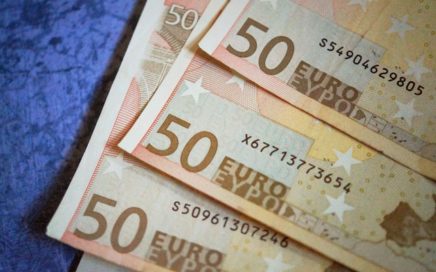Currency in Italy
A Travel Money Guide to Italy
So you’re heading to the boot-shaped land that gave us pizza, pasta, gelato, tiramisu, truffles… And that’s only listing the food! There’s no doubt you’re going to have a blast in Italy.
But you can make your savings go even further with a few clever choices, including how you’ll exchange currency and pay for things in Italy.
What Currency does Italy use?
Today, Italy uses the euro. It is a part of the eurozone – the region of European countries that use the euro as their official currency. The Vatican City also uses the euro as its official currency.
The currency sign for the euro is € while the code is EUR. In Italy, it’s more common to see the symbol written after the numeral, as in 10€.
The second most traded currency on the world’s foreign exchange markets, the euro is issued by the European Central Bank.
It replaced Italy’s old currency, the Italian lira (lire as a plural), which was legal tender until February 2002.
Italian Money
The euro uses a decimal system made up of euros and cents, with one euro equalling 100 cents.
The euro has eight coin denominations: one cent, two cents, five cents, ten cents, 20 cents, 50 cents, €1, and €2.
Banknote Denominations
Euro banknotes in Italy are identical to those across the eurozone with no national design. Each banknote differs in size and colour.
There are eight denominations (€5, €10, €20, €50, €100, €200, and €500) although realistically only the four smaller denominations are commonplace.


Coin Denominations
Euro coins differ from one country to another within the eurozone only by their national design. In Italy, one side of every euro and cent coin features Italian icons, such as famous architecture, sculptures, or artwork.
The other side is standardised across the eurozone and features the numerical value of the coin and a map of the European Union. Euro currency coins are valid across the eurozone, no matter their country of origin.

Other useful information that might help you understand the Italian money include:
- Most places in Italy will not accept 200 or 500 note but most people use 50's instead.
- Using cash in Italy is more common that France so it is handy to have some foreign currency in cash on hand.
- Each coin and coin series is made from a different mix of metals although the usually include copper, zinc and aluminium and tin.
- The €500 euro note was only printed once in the first series although it still remains legal tender.
Using Your Bank Card in Italy
Compared to many other countries in Europe and around the world, Italy remains a predominantly cash-driven society.
While you can still use your bank card in many establishments, many Italian restaurants, cafes, shops, and hotels still prefer cash.
Some of the best travel money cards include debit, credit and prepaid cards. Visa and Mastercard are accepted almost without issue across Italy, although American Express is harder to use and you may pay a higher surcharge.
The bank card product you choose will determine how much you end up paying in additional fees and charges.
Hot tip: When using your bank card, watch out for dynamic currency conversion (DCC). This is where you’ll be asked whether you’d like to pay in the local currency or your home currency. Always choose the local currency! DCC is well known to provide poor currency conversion rates and you may pay additional fees for the service.
Debit Cards
While contactless technology isn’t commonplace yet, you’ll have no trouble using a debit card with a chip and PIN. Debit cards with magnetic strips aren’t as widely accepted.
There’s no doubt debit cards are convenient but you might end up paying high fees for the currency conversion, foreign transaction, and overseas ATM withdrawals.
One of the best travel money cards for Italy is the Wise Travel Card, which doesn’t have purchase, load, or reload fees and offers the same exchange rates as those you see on Google or XE.com.


Credit Cards
All major credit cards are accepted in Italy, but American Express is less recognised than Visa or Mastercard.
Brush up on the costs of using your credit card overseas. Using credit cards in ATMs, for example, can incur overseas withdrawal fees and cash advance fees.
Also, don’t rely on your credit card alone; many smaller trattorias, pensioni, and pizzerias are cash-only.
Prepaid Travel Cards
It’s natural to gravitate towards a prepaid travel card, considering the product is designed for travellers.
But while you may get a backup card for security and save on currency conversion fees, you might also end up paying in load and reload fees, inactivity fees, and ATM withdrawal fees from the card company.
The Revolut and TransferWise debit cards are your best option if you like to lock in your currency and load a prepaid amount onto your card.

How to Exchange Currency in Italy
Many Italian restaurants and shops prefer cash, making it essential that you have a little on hand as you travel. While it can be better value to buy the currency before you go (see our section on that below), you can also get currency once you arrive in the country.
The most popular ways to exchange currency in Italy is by using ATMs, currency exchange outlets, or travellers cheques.

Italian Bank ATMs
A godsend, most ATMs in Italy don’t charge the ATM operator fee you see in many other countries.
Italians call bank ATMs bancomats and these are the ATMs without fees – avoid independent ATMs as they charge hefty fees.
Even if you don’t face ATM fees, you may still be hit with your own bank fees for using your card overseas so be sure to read up on costs and charges before you go.
You’ll probably have a withdrawal limit of between €250 – €300 per day. Italian ATMs have been known to be temperamental with foreign cards so it’s always a good idea to make sure you have some money on you at all times.
Travellers holding Westpac bank cards (bank cards from Westpac, St George, Bank of Melbourne, and BankSA) can use BNP Paribas ATMs to avoid paying international ATM withdrawal fees.
Italian Currency Exchange Outlets
Currency exchanges, called cambios, are available all over Italy, but the fees and rates can vary dramatically.
Currency exchange counters at airports and hotels are probably going to give you poor exchange rates, so it’s better to wait until you can compare options in town.
Keep in mind that bureaus in popular tourist destinations, especially around famous landmarks, often give poor exchange rates and add on high or hidden fees.
Make sure the notes you bring from home are in good nick. Some exchange services reject defaced or damaged banknotes.


Travellers Cheques
Even though it’s one of the most visited countries in the world, Italy is no longer particularly friendly towards travellers cheques.
They can’t be used as direct payment, so the only way to use them once you’re in the country is to swap them for currency at a bank or bureau de change office. Even then, very few banks will accept travellers cheques if you don’t have an account with them. And exchange services apply exorbitant fees and rates to them.
So in the end, it’s better to stick with ATM withdrawals and currency exchanges if you’re looking for convenience and better value.
Buying Italian Currency Before You Go
Chances are you’ll hit the ground running once you arrive in Italy. So why waste a second searching for cambios or bancomats?
Save yourself some money by purchasing those Italian euros back home. The 3 best ways to do this are:
- Buying euros online to be delivered or for you to pick up in-store.
- Swapping AUD for EUR at a currency exchange store.
- Buying euros at the airport.
Try S Money or a similar online currency exchange store to get rates that reflect the comparisons you see on XE or Google.
If you choose online delivery or in-store pickup, check the processing time. Some exchange companies with online options suggest you allow between two and five days to process currency.
Prefer in-store currency exchange? Head to the CBD of your nearest city for the most competitive exchange rates; suburban bureau de change outlets tend to have poorer rates and fees.
Currency exchange counters in Australia’s airports are infamous for their atrocious exchange rates. Avoid them if you can.
What Will the Italian Euro Buy Me?
It’s handy to cost out your trip before you go so you know just how much money to exchange. Prices vary across Italy but here are some average costs:

€110-200 per night
A double room in a mid-range hotel

€2.50
A slice of pizza

€3
A bottle of local Italian wine

€10-20
A typical museum entry ticket

€25-45
Dinner at a local restaurant
Leftover Euros at the End of Your Trip? What to Do with That Unused Cash

It’s annoying returning from a trip with a wad of foreign cash but there are plenty of ways to dispose of these unwanted coins and notes:
- Your airline might distribute envelopes for currency collection to donate to charities (check out Qantas’s Change for Good program with UNICEF).
- Australian international airports often have collection boxes for unwanted currency, which is donated to charity.
- Drop off your currency at any branch of the Commonwealth Bank of Australia, which then gives every cent to UNICEF.
- Change your Italian currency either at the airport or, better yet, with a money changer in the city.
- Why not hold onto those euros for a friend just heading off? It’ll be a lovely surprise and going away gift for them!
- Keep your money for later trips to Europe. The euro is the official legal currency of 19 eurozone countries and accepted by many more.
7 Travel Money Tips for Trips to Italy
Many tourists waste money through not finding the best ways to exchange their currency. To help you avoid this quandary, here are a few practical tips to help you get the most bang for your … euros:
- Avoid the airports! Currency exchange bureaus at the airport charge epic fees. If you like a good deal – or even just a reasonable one – avoid these at all costs.
- Only carry what you need – It can be expensive to change euros back into AUDs so only take what you think you’ll spend. Not only this – nobody likes to tuck wads of notes into their socks and toiletries for safekeeping on longer journeys.
- Ask for a mix of denominations – Make it easy on yourself and the vendors by getting a mix of smaller notes.
- Check your exchange rate – Google and XE.com are the standard market exchange rate but you’ll notice how wildly bank and currency exchanges can vary their rates. Try to get as close to the market rate as possible.
- Look out for hidden fees – The bane of our (financial) existence, hidden fees will often make a huge difference to the cost of your holiday. Be particularly wary of hidden bank fees for overseas card usage.
- The right card makes all the difference – Having a card is convenient but it can take a hit to the bank account if you have the wrong card. Research and arm yourself with the best card for travel for big savings.
- Mix it up! Many travellers only use their credit card while some only think about cash. But the best option depends on your situation. Save the card for huge purchases such as hotels and car hire and reserve your cash for smaller wins – transport, attractions, or meals out.

The Latest Euro Dollar news

2024 AUD EUR Forecasts
The Australian dollar is facing a mixed outlook against the Euro in 2024. The Australian dollar (AUD) has struggled against the Euro (EUR) in recent months. The EUR, which is the official currency of 19 of the 27 European Union (EU) member countries, peaked above €65.6¢ in January 2023. But it then saw a consistent decline, falling below the €60¢ barrier in the second half of the year. There are mixed forces at play which affect the value of the Euro, which covers a diverse area including the major economies of Germany, France and Italy

The Best European Travel Insurance for Australians
An adventure around Europe is a rite of passage among Australians. While there’s plenty to look forward to, it’s also important to prepare for unplanned events. That’s where getting travel insurance for Europe can help. A comprehensive policy makes sure you receive the medical treatment you need in an emergency and reimburses you for lost, stolen, or damaged personal belongings. These days, comparing international travel insurance policies can also protect you from unexpected costs or emergencies arising from COVID-19.

2023 AUD EUR Dollar Forecasts
This article looks at what the banks are predicting for the AUD to EUR exchange rate over the long term in 2023. The 2024 AUD EUR Forecasts are out now With most of 2023 out of the way, attention turns to 2024. Now that most economists have released their predictions for the AUD EUR exchange rate, head here to find out the most up to date forecasts:

